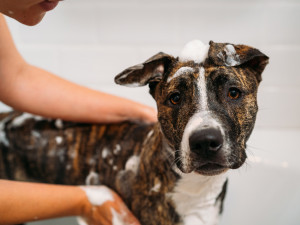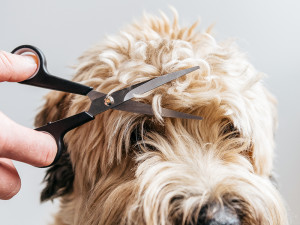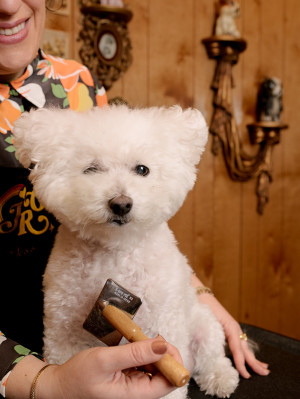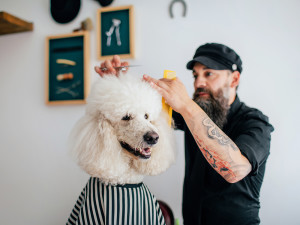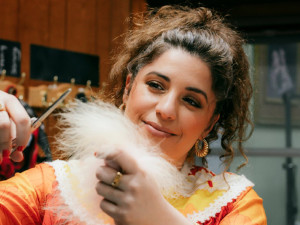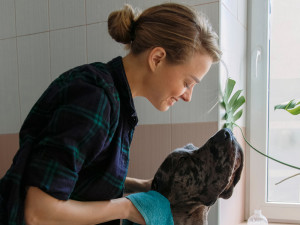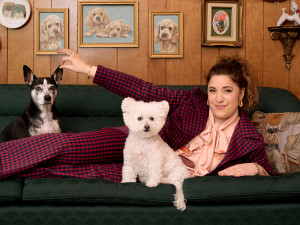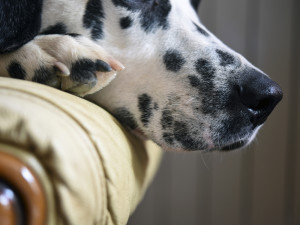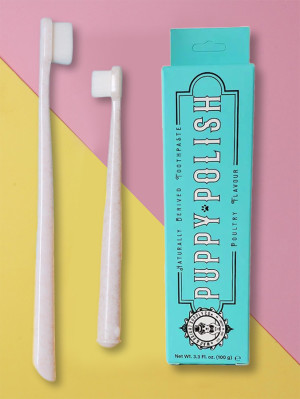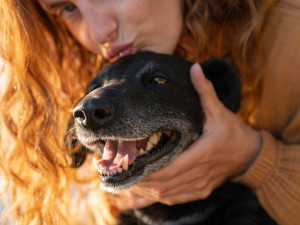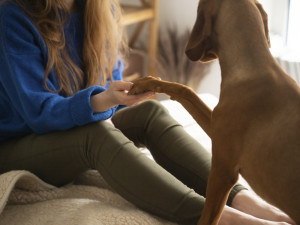How Often Should You Groom Your Dog?
Just make sure you spell out “B-A-T-H.”

Share Article
Dogs have a tendency to gravitate toward dirt, mud, and anything gross they can find outside. While you definitely need to give your dog a bath after an encounter with nature, how often should you get your dog groomed?
Unfortunately, there’s no short and easy answer. Grooming frequency depends on your dog’s breed, coat type, how long you like to keep their fur, and even their age. “It just depends on the dog,” Kinship Collective member Jess Rona of Jess Rona Grooming in Los Angeles told Kinship.
Kinship explores how often different dogs need grooming based on their type of coat, as well as when you need to break out the canine nail clippers and the peanut butter-flavored toothpaste.
Why is a proper grooming routine important for dogs?
You probably enjoy feeling clean and fresh, and your dog does too, no matter how much they love a good roll in the dirt at the park. But there are a ton of benefits of dog grooming beyond just a shiny coat. Grooming helps to keep your dog’s skin and coat healthy, which in turn plays a major role in your pup’s overall healthopens in new tab. A regular grooming routine can prevent fleas and ear mites, eliminate dead hairs, and remove dead skin, as well as help keep your dog’s skin from becoming irritated.

Taking your dog to a professional groomer on a regular basis can also help them grow accustomed to regular handling, making those annual vet visits a little easier on both parties. Plus, a groomer gets up close and personal with your dog, allowing them to discover health issues under your pet’s fur, such as skin conditions, cysts, and even ear infections.
How often should you get your dog groomed?
Getting your dog grooming schedule set is important to protecting your pet’s health, but how often your dog needs a bath will depend on their fur type, as well as the amount of time they spend outside. And it’s important not to overdo it — bathing your pup too often can result in itchy, dry, and sensitive skin.
So how often should you groom your puppy? In general, most dogs do well with a bath every six to 12 weeks and the occasional nail trim. Keep an eye on your dog, and if you notice any dirt in their fur, it may be time to run the bath. It also doesn’t hurt to research your dog’s breed (or breeds) and coat type to determine the best grooming schedule.
Consult with your veterinarian or a qualified groomer
Before you attempt to groom your dog yourself, you may want to talk to your veterinarian or even a professional groomer. Either one can recommend the best products to use on your dog, as well as how often your pup needs to be bathed.
Types of dog coats
Not all dogs are alike, and between purebreds and mixes there is quite a range of dog coatsopens in new tab. Whether your dog is short-haired, long-haired, or even curly-haired (think Poodles) can have an impact on how often they need grooming or even whether they need the occasional haircut.
Short-haired coats
Short-haired dogs tend to have smooth, short coats and are sometimes hypoallergenic because of their lower level of dander. Short-haired breeds include Pit Bulls, Pugs, Boston Terriers, Labrador Retrievers, and Bull Terriers.
Long-haired coats
Long-haired dogs are known for their long and often silky coats that require more maintenance than their short-haired counterparts. Long-haired dogs include some Poodle mixes, Lhasa Apsos, Collies, and Shih Tzus.
Thick undercoats
Dog breeds that originated in colder climates often have thick undercoats to protect them from frigid winters. Siberian Huskies, Akitas, Old English Sheepdogs, and Alaskan Malamutes all have thick undercoats.
Silky coats
Some long-haired dog breeds also have very silky coats, like Shih Tzus and Lhasa Apsos. But even dogs with medium-length coats may also have a silky shine to their fur, such as the Maltese, Yorkshire Terrier, and Samoyed.
Curly haired and wire-haired dogs
Curly-haired dogs include Poodles (and many Doodle mixes), Bichon Frises, and Cocker Spaniels. Wire-haired dogs are less on the fluffy side, with a coarser coat, and examples include the Airedale Terrier, the Brussels Griffon, the Jack Russell Terrier, and the Dachshund.
Hair cutting
Do dogs need haircuts? Not all dogs need regular trims; in fact, many short-haired dogs do well with just bathing and nail trims as part of their grooming schedules and don’t need haircuts. Be sure to research your dog’s coat type and talk to a professional groomer or your vet before breaking out the trimmer.
How often should you trim short-haired dogs?
Do short-haired dogs need haircuts? Short-haired dogs actually don’t need to be trimmed, and doing so can actually be harmful to your dog because the cutting occurs close to their skin. Unless your vet recommends a haircut for medical reasons, leave your short-haired dog’s coat as is.
How often should you trim long-haired dogs?
Long-haired dogs, on the other hand, require quite a bit of maintenance, including regular haircuts. You’ll want to have a professional groomer trim your long-haired dog every eight to 12 weeks. How long your dog can go between haircuts will depend on their coat, as well as how long you want to keep their fur. Plus, if you take the time to brush your dog daily, you can go longer between trims.
How often should you trim dogs with thick undercoats?
Dogs with thick undercoats need that extra layer groomed and removed around every eight to 12 weeks. Doing so helps the dog’s skin breathe without losing the insulation they need to stay warm. As for trimming, avoid taking off more than half an inch. Removing too much fur can slow down the undercoat’s ability to regrow. Because the grooming process for these dogs is a bit more involved, you should definitely invest in regular appointments with a professional groomer.
How often should you trim dogs with silky coats?
Dogs with silky fur usually don’t have an undercoat, and their skin tends to be more oily. If you want to trim your dog, aim for a regular haircut every four to eight weeks, depending on how long you’d like to keep their fur.
How often should you trim curly haired or wire-haired dogs?
Curly-haired dogs, like Poodles, need regular trims every six to eight weeks to keep their fur from growing too shaggy and becoming matted. Similarly, wire-haired dogs require trims every four to eight weeks.
Bathing
Getting your dog on a regular bathing schedule can help them become used to the routine — and hopefully a little less stressed about hopping in the tub. Just like haircuts, how often you should wash your dog depends on their coat type, as well as how much time they spend outside.
How often should you bathe short-haired dogs?
Because of their short hair, these breeds are less likely to accumulate dirt or become matted. Dogs with oilier skin tend to benefit from regular baths every four to six weeks, while dogs with less oily skin can get away with a bath every six to 12 weeks.
How often should you bathe long-haired dogs?
Without proper grooming, long-haired dogs can become matted, so plan to bathe your dog every four to six weeks.
How often should you bathe dogs with thick undercoats?
Dogs with thick undercoats need monthly baths to ensure their health and comfort. A professional groomer can help keep your dog clean and fresh.
How often should you bathe dogs with silky coats?
Dog breeds with silky coats tend to need baths a bit more frequently because of their naturally oily skin. You may even want to add some baking soda to their bathwater to help balance out the pH.
How often should you bathe curly haired or wire-haired dogs?
Both curly-haired and wire-haired dogs have fur that easily attracts dirt, so regular baths every three to four weeks are a must. “Your dog’s coat can pick up things like a dust mop, especially the Doodle set,” Laura Gamarro, a dog groomer, says. “Their hair grows twice as fast as any other dog, and their fur has many different textures — it’s very unpredictable, stringy, curly, and super dense.”
Brushing
How often should you brush your dog’s fur? Every dog can benefit from the occasional brushing session. Plus, brushing your dog can help strengthen your bond and make them feel more comfortable with regular handling, which can come in handy for visits to the vet and groomer.
How often should you brush short-haired dogs?
Weekly or even daily brushing can help distribute the oils throughout the skin of a short-haired dog, as well as remove any debris that accumulates in their coat. A curry brush is the best option for when your short-haired dog is shedding, which can happen at any time of year. If they have an undercoat, try to brush at least every other day to remove any loose hairs that can be caught in the undercoat and cause skin irritation.
How often should you brush long-haired dogs?
Because of their coats, long-haired dogs need to be brushed every day if you plan to keep their fur longer to remove any tangles and avoid matting. Fortunately, the more you brush at home, the longer you can go between trips to the groomer. However, if you don’t have time for daily brushing sessions, your groomer will probably recommend more frequent visits.
How often should you brush dogs with thick undercoats?
Dogs with thick undercoats also need daily brushing. Look for a brush specifically designed for dogs with undercoats to help keep their fur healthy.
How often should you brush dogs with silky coats?
If your dog has a silky coat, take time to comb and brush their fur every day to eliminate any tangles and avoid matts.
How often should you brush curly haired or wire-haired dogs?
Curly-haired and wire-haired dogs require the most maintenance, and that includes daily brushing. If you choose to keep their coat long, you may even want to brush two or three times a day.
How often should you trim your dog’s nails?
Thanks to walking on pavement, many dogs’ nails wear down naturally, but some pups may still need a regular nail trim. Make sure to purchase pet-safe nail clippers designed for trimming your dog’s claws and watch some tutorial videos to learn how to safely trim your dog��’s nails because, if you cut the nails too short, you can cause injury and bleeding.
How often should you clean your dog’s ears?
Keeping your dog’s ears clean can help prevent infection, so take time to clean your pup’s ears at least once a month. If your dog has long, floppy ears or they spend a lot of time in the water, they may need their ears cleaned more frequently, such as every other week or even once a week.
How often should you brush your dog’s teeth?
Just like humans, dogs benefit from twice daily teeth brushing, which can be something of a challenge for many pet parents. Try brushing your dog’s teeth at least three times a week to remove plaque and prevent the accumulation of tartar. And you can always substitute other dental care products for a toothbrush, such as dental treats, water additives, or dental wipes.
Adjust the grooming frequency as needed
While these recommendations are good general rules, you may need to adjust your grooming schedule depending on your dog’s needs. For example, if you enjoy hiking with your dog, you may have to give them baths more frequently to keep dirt from accumulating on their coat and skin. Consult with your vet or a professional groomer to find the right grooming schedule and tools for your dog.
FAQs (People also ask)
What if my dog dislikes grooming?
Most dogs eventually grow used to bathtime, but some may still be anxious or reluctant to hop in the tub. Try encouraging your dog into the bathroom with treats or even smearing peanut butter on the side of the tub as a tasty distraction.
Are there signs of skin or coat issues I should watch for during grooming?
As you groom your dog, keep an eye out for bald patches in their fur, which could be a sign of a skin condition or allergies. You should also watch for things like:
Mats in the fur of long-haired dogs, which can cause skin irritation and infection
Fleas or ticks
Changes in color in areas where your dog licks frequently
Bumps, rashes, or skin discoloration
Take time during grooming to check your dog’s feet as well for any signs of skin irritation, such as redness or swelling. If you notice any of these issues, consult your vet.
Can I groom my dog myself?
If your dog is short-haired or you simply can’t afford frequent visits to a professional groomer, you may try DIY dog grooming. Regular baths, brushing, and nail trims can often be done at home, as long as you purchase the appropriate tools for your dog’s coat.
Resources
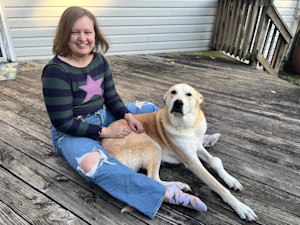
Savannah Admire
Savannah Admire is a writer and pet mom to two dogs and a cat. Under the name Savannah Cooper, she has published poetry in 40 different publications, as well as a poetry book, Mother Viper (2025). When she’s not writing, you can find her reading, taking photos, or volunteering as a content creator for her local community theatre. As a pets writer, she focuses on cat and dog behavior and pet parenthood. She currently lives in Western Maryland.
Related articles
![Jess Rona laying on a green couch in a vintage style living room, playfully pinching the ear of a dog sitting beside her while another white dog sitting in front of her]()
The Title of Best Hairstylist in LA Belongs to Jess Rona
No matter their star status, all of Rona’s clients are classified as “cozy bears.”
![Spotted dog with a close up of his nose]()
What to Do If Your Dog Has a Cracked, Broken, or Torn Nail
A vet explains when you can treat the injury at home — and when it’s best to seek professional help.
![Wag & Bright Supply Co Toothpaste and toothbrush for dogs.]()
The New Status Grooming Product is Toothpaste — For Your Dog
The toothpaste that’ll have their teeth sparkling like a Kardashian’s.
![Close up of red headed woman holding a black dog's face showing his teeth]()
They’re Just Like Us: Dogs Get Gingivitis
Dogs can suffer from gum disease, too. Here’s how to prevent it.
![A woman trimming a dog's nails]()
How to Trim Your Dog’s Nails
Five simple steps for trimming your dog’s nails at home.
![A festive shot of the Pupwell fancy dog grooming kit including a Travel bag, a Slicker Brush, a De-matting comb, a Fine tooth comb, a Metal tooth comb and three metal Christmas tree decorations in front of a burgundy background]()
Pupwell’s Luxury Dog Grooming Kit Helps Pups Shed Fur, Not Tears
More grooming, less fight (as long as you use the provided lick mat).
